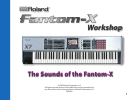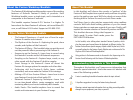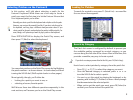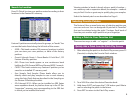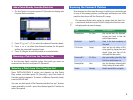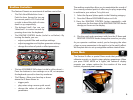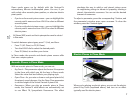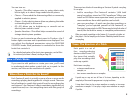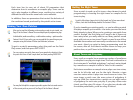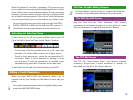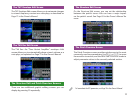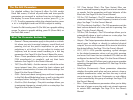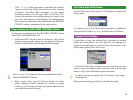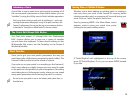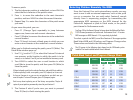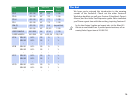
8
You can turn on:
• Tremolo—This effect causes notes to swing side-to-side,
left-to-right, as in classic Stage-model electric pianos.
• Chorus—Chorus adds the shimmering effect so commonly
applied to electric pianos.
• Phaser—Funky electric pianos often use phasing that adds
a whooshing swirl to the sound.
• EQ—EQ allows you to brighten-up or smooth out an
electric piano sound to taste.
• Speaker Simulator—This effect helps recreate the sound of
vintage electric piano speakers.
To turn on and customize an effect, press its F button—the F
button lights onscreen and its parameters are displayed. You
can adjust the displayed parameters using the REALTIME
CONTROL knobs. Each parameter is numbered to show the
knob that controls it.
For a detailed explanation of the electric piano parameters, see the Effect
List section of your Owner’s Manual, starting on Page 270.
How a Patch Works
If you want to edit patches or create your own, you’ll need
to understand what makes a patch tick, so to speak. In this
section, we’ll discuss the mechanics of a patch.
Where Does a Patch Get Its Sound?
Each Fantom-X patch is actually a group of one or more audio
recordings playing back together as a single sound. There are
lots of settings in a patch that control how the recordings play
and interact—the Fantom-X effects contribute significantly to
a patch’s sound, too—but everything starts with this group of
recordings.
There are two kinds of recordings a Fantom-X patch can play.
It can play:
• built-in recordings—The Fantom-X contains 1,436 brief
sound recordings stored as PCM “waveforms.” When you
install an SRX Series wave expansion board, you add even
more waveforms from which patches can be built.
• your own recordings—A patch can also play recordings, or
“samples,” you’ve captured yourself on the Fantom-X, or
that you’ve imported via USB. These may be brief chunks of
sound, like the built-in waves, or complete performances.
When you sample something on the Fantom-X, it’s a patch or rhythm set
that plays it. See the Sampling on the Fantom-X Workshop booklet for more
on sampling.
Tones: The Structure of a Patch
Each patch is a set of
four sound-producing
devices called “tones.” It’s
the tones that actually
play the recordings that
make up a patch.
Each tone can play:
• a stereo waveform or
sample, or
• two mono waveforms or samples.
A patch may or may not use all four of its tones, depending on the
complexity of the sound its programmer is trying to achieve.
A tone doesn’t have to play a stereo waveform or sample, or two mono
waveforms or samples—it can play a single mono waveform or sample
if you like.
5POF
5POF
5POF
5POF
1BUDI
5POF
5POF
5POF
5POF
1BUDI



